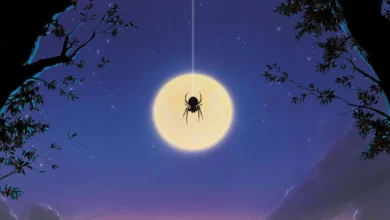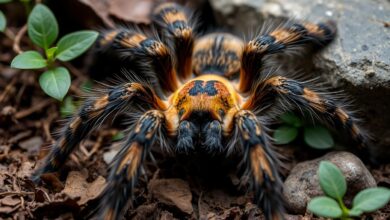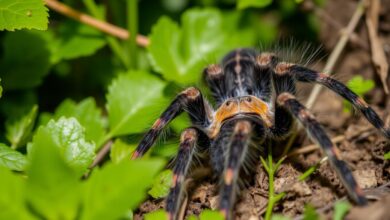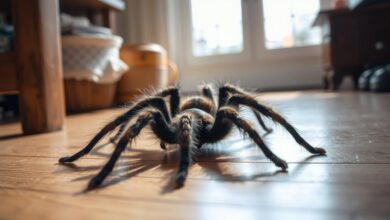Can tarantulas kill you?
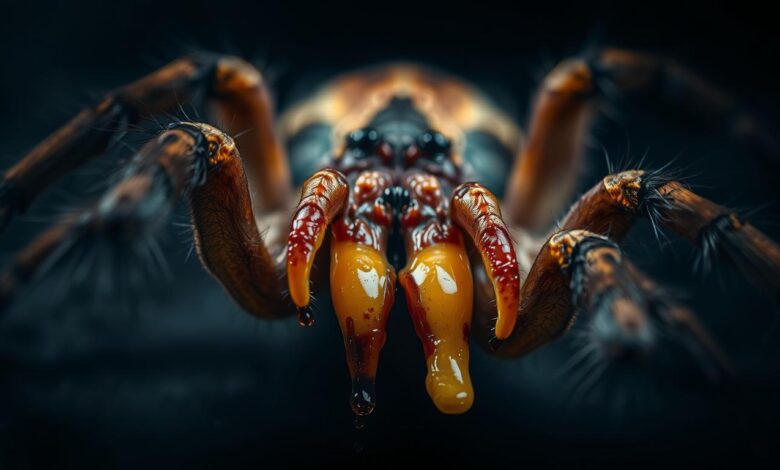
Tarantulas, with their large size and hairy bodies, often spark fear and curiosity. Many ask if these spiders can be deadly to humans. We’ll look into tarantula venom, the risks of bites, and the myths and facts about them.
Tarantulas are big and look scary, but they’re not usually a danger to people. Their venom is strong, but most tarantulas in the U.S. and other places can’t kill humans. Most bites cause mild to moderate symptoms like pain, swelling, and redness.
But, there are some exceptions. Some tropical tarantulas have venom that could be dangerous. Also, people with allergies to insect or arachnid venom might react worse, even to a mild bite.
Understanding Tarantula Venom
Tarantulas are fascinating creatures known for their striking looks. They have a special defense – their venom. This powerful toxin is key to their survival and hunting. Let’s explore tarantula venom, its types, and how it works.
Types of Venom
Tarantulas make many kinds of venom, each with its own traits. Some venom is mild, while others are strong and can harm humans. The types of venom in tarantulas include:
- Neurotoxins: These affect the nervous system, causing paralysis or breathing problems.
- Cytotoxins: This venom damages cells, leading to tissue death and other local effects.
- Hemotoxins: This venom messes with the blood system, causing bleeding or clotting issues.
Potency and Effects
The strength of tarantula venom varies by species and spider. Some venom is mild, causing only pain and swelling. Others are stronger, leading to symptoms like nausea, muscle spasms, or heart problems in rare cases.
The venom potency and effects depend on several factors. These include the tarantula’s size, the amount of venom used, and how the person reacts. Knowing these details helps us understand the risks of tarantula encounters.
Can tarantulas kill you?
Many people fear tarantulas because of their venom. But, most tarantula species are not very dangerous to humans. Most bites cause only mild reactions, and there are very few cases of death from tarantula bites.
The venom of most tarantulas is not deadly to humans. The strength of their venom varies by species. But, it’s usually not strong enough to cause serious harm or death. Still, it’s important not to ignore tarantula bites. People with allergies might have more severe reactions, which could be dangerous.
| Tarantula Species | Venom Potency | Risk to Humans |
|---|---|---|
| Goliath Birdeater | Moderately Potent | Low to Moderate |
| Poecilotheria (Ornamental Tree Spiders) | Highly Potent | Moderate to High |
| Brachypelma (Mexican Red-Knee) | Mildly Potent | Low |
| Grammostola (Chilean Rose) | Mildly Potent | Low |
Even though the chance of dying from a tarantula bite is small, it’s still wise to be careful. Knowing about tarantula venom toxicity and taking safety steps lets you enjoy these amazing spiders without worry.
Spider Bites and Symptoms
Meeting a tarantula can be shocking. The thought of getting bitten is scary. But, tarantula bites are usually not dangerous to people. They can still cause some uncomfortable symptoms.
It’s important to know how to spot the bite marks and treat them. This helps keep you safe and healthy.
Identifying Tarantula Bite Marks
Tarantula bites have two clear punctures, sometimes with a bit of blood. The area might look a bit red and swollen. You might feel pain, itching, or a burning feeling.
If you think you’ve been bitten, look closely at the area. This will help you understand the bite better.
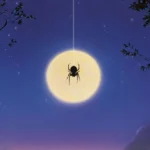 Arachnophobia in Australia: How to Live with Spiders
Arachnophobia in Australia: How to Live with Spiders
Treating Spider Bites
First, clean the bite with soap and water. Then, use a cold compress to lessen swelling and pain. See a doctor if you have serious symptoms like trouble breathing, dizziness, or an allergic reaction. Usually, you can treat the bite with over-the-counter pain relievers and antihistamines.
Remember, tarantula bites might be uncomfortable, but they’re not usually dangerous. Knowing the signs and acting right can help you stay safe and reduce the effects of a spider bite.
Venomous Spiders: Myths and Facts
There are many myths about venomous spiders that need to be cleared up. While some spiders have strong venom, the danger they pose is often overstated. It’s important to know the truth about these spiders to make smart choices when we meet them.
One myth is that venomous spiders can kill you. But, most spider species are not dangerous to humans. Only a few, like the black widow and the Brazilian wandering spider, can cause serious harm. Even then, deaths from spider bites are very rare.
- According to National Geographic, there are around 45,000 species of spiders worldwide.
- Spiders like warm, dark, and humid places, like bedrooms, for food, shelter, or mates.
- Spiders eat insects like mosquitoes, flies, moths, and roaches, helping our ecosystems.
Another myth is that spider bites are always dangerous. While some spiders, like the black widow, can bite painfully and harm, most bites are mild. Many “bites” are actually from pests like ticks or bed bugs.
To clear up these myths and learn the truth about venomous spiders, it’s key to educate yourself. Look for reliable information from trusted sources. By knowing the facts, we can make smart choices and take the right steps when we meet these fascinating creatures.
Tarantula Defense Mechanisms
Tarantulas are often misunderstood. They have evolved defense mechanisms to protect themselves. Knowing these can help you avoid startling them.
Defensive Behaviors
One famous defense is the threat posture. When threatened, a tarantula raises its front legs and flares its fangs. It may also lunge to look bigger and scarier.
Another defense is the flicking of urticating hairs. These tiny hairs irritate the skin and eyes of attackers. It’s a good way to keep away birds or small mammals.
Some tarantulas can also leap at threats. This is not as common but can surprise predators.
Understanding tarantula defenses shows their amazing survival skills. Respecting these behaviors keeps you safe and avoids conflicts.
Deadly Arachnids: The Most Dangerous Spiders
While tarantulas are not the deadliest dangerous spiders, some spiders are much more dangerous. The black widow, Brazilian wandering spider, and Sydney funnel-web spider are among the most venomous spiders in the world. Their venom is very potent, and their bites can be severe. It’s important to know which deadly spiders to avoid for our safety.
The Sydney funnel-web spider is the most dangerous to humans. Its venom can kill in minutes. In the last century, these spiders have caused 13 deaths. The black widow spider’s venom is 15 times stronger than a rattlesnake’s, leading to over 2,500 visits to U.S. poison control centers each year. The brown recluse spider’s venom can cause serious skin damage, leading to infections that can be fatal.
There are over 50,000 known spider species, but only about 25 can seriously harm or kill humans. Most spiders are not aggressive and avoid humans. To stay safe, wear gloves when handling wood, check your clothes and bedding for spiders, and shake out your boots. Keeping tetanus shots current and washing the bite area with soap and water can also help. If bitten by a venomous spider, seek medical help right away.
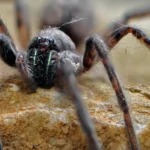 Secretos de las Tarántulas: Muda, Veneno y Estrategias de Caza
Secretos de las Tarántulas: Muda, Veneno y Estrategias de Caza
| Spider Species | Venom Potency | Threat Level |
|---|---|---|
| Sydney Funnel-web Spider | Extremely Potent | High |
| Black Widow Spider | Highly Potent | High |
| Brown Recluse Spider | Moderately Potent | Moderate |
Spider Toxicity and Fatalities
While it’s rare, some people have died from spider bites. This mostly happens with the most venomous spiders. Knowing which spiders are most toxic helps us stay safe and get help when needed.
Recorded Spider-Related Deaths
Spider bites can be deadly, but it’s not common. Here are some examples:
- In the United States, the black widow spider and the brown recluse spider cause most deaths. About 2-3 people die each year.
- In Australia, the funnel-web spider is very dangerous. Since 1927, it has killed around 13 people.
- In South America, the Brazilian wandering spider has deadly venom. It has been linked to a few deaths.
These numbers show some spiders can be deadly. But, the chance of dying from a spider bite is still very low. Taking the right steps and getting medical help fast can help avoid serious problems.
| Spider Species | Region | Recorded Deaths |
|---|---|---|
| Black Widow | United States | 2-3 per year |
| Brown Recluse | United States | 2-3 per year |
| Funnel-Web Spider | Australia | Around 13 since 1927 |
| Brazilian Wandering Spider | South America | Small number |
Spider Safety Precautions
Spiders are fascinating, but safety is key when you meet them. Stay alert and know your surroundings to avoid risks. Always remember to not touch or disturb spiders. This can make them bite you.
Avoiding Spider Encounters
To avoid spiders, follow these steps:
- Watch out for spiders in dark spots, woodpiles, and damp places.
- Shake out clothes, shoes, and items from outside before bringing them inside.
- Keep your home tidy and free of clutter. Spiders like messy places.
- Use bug sprays or natural repellents like essential oils to keep spiders away.
- Turn off outdoor lights at night to keep insects away, which spiders eat.
First Aid for Spider Bites
If you get bitten by a spider, see a doctor right away. Most bites aren’t serious, but quick care is important. Here’s what you can do first:
- Wash the bite with soap and water.
- Use a cold pack to reduce swelling and pain.
- Don’t scratch or rub the bite. It can make it worse.
- Watch for serious signs like trouble breathing or swallowing. Get emergency help if you see these.
By being careful and knowing first aid, you can stay safe from spider bites.
| Spider Species | Average Size | Venom Potency |
|---|---|---|
| American House Spider | 1/8 to 5/16 inches | Low |
| Wolf Spider | 1/2 inch to over 2 inches | Moderate |
| Jumping Spider | 1/8 to 3/4 of an inch | Low |
| Brown Recluse Spider | 3/8 inch | High |
| Black Widow Spider | Up to 1.5 inches | High |
| Yellow Sac Spider | 1/4 to 3/8 inches | Moderate |
Tarantula Attack: When Provoked
Tarantulas are usually calm, but they can get defensive or even attack when scared or provoked. Knowing when a tarantula attack might happen is key to staying safe around them.
Most tarantulas are not aggressive towards people. But, they have a defense that can kick in if they feel threatened. This might happen if they see sudden movements, are handled, or if someone gets too close to their space. When scared, a tarantula might stand up its front legs, release hairs from its back legs, or even bite in self-defense.
- Making sudden or unexpected movements near a tarantula’s home can scare it and lead to an attack.
- Trying to touch a tarantula, even if it looks calm, can make it feel threatened and lead to a tarantula attack.
- Getting too close to a tarantula’s hiding spot or burrow can also make it aggressive.
It’s important to be careful and respectful around tarantulas. Watching them from a distance, moving slowly, and not touching them helps avoid tarantula attacks. This way, you can enjoy watching them safely.
| Behavior | Potential Trigger | Outcome |
|---|---|---|
| Raising Front Legs | Perceived Threat | Defensive Posture |
| Rubbing Hind Legs on Abdomen | Feeling Threatened | Release of Urticating Hairs |
| Striking with Fangs | Extreme Provocation | Potential Bite |
By knowing what might make a tarantula attack and respecting their space, you can enjoy watching them. This way, you can appreciate their beauty without getting hurt.
Exotic Pet Tarantulas: Risks and Care
Tarantulas are becoming more popular as pets. But, owning one comes with risks and duties. It’s important to do your homework and take the right steps to keep both you and your tarantula safe.
Tarantulas are mostly calm, but their size and venom can be dangerous if mishandled. There are risks like bites, escapes, and special care needs. To keep your tarantula healthy, you need to provide the right temperature, humidity, and food.
Before getting a tarantula, learn about the species you want. Know what it needs and how to keep it safe. With the right care, having a tarantula as a pet can be very rewarding.
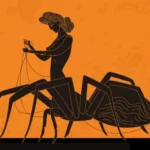 Las Tarántulas en la Cultura Popular: Un Vistazo a su Influencia
Las Tarántulas en la Cultura Popular: Un Vistazo a su Influencia
